Texes science - Study guides, Class notes & Summaries
Looking for the best study guides, study notes and summaries about Texes science? On this page you'll find 186 study documents about Texes science.
Page 3 out of 186 results
Sort by

-
TExES Science of Teaching Reading (STR) (293) Quiz 4 Questions and Correct Answers & Latest Updated
- Exam (elaborations) • 8 pages • 2024
- Available in package deal
-
- $9.99
- + learn more
How are daily learning objectives related to reading developed? A by analyzing the steps necessary to reach long-term goals that are based on state learning standards B by determining what skills are naturally connected to a specific text or theme C by referencing daily learning objectives laid out in the state curriculum documents D by analyzing the results of the summative assessments from the previous year to determine which skills should be covered more extensively o :## A A ki...
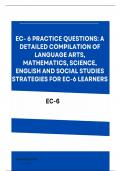
-
EC- 6 PRACTICE QUESTIONS: A DETAILED COMPILATION OF LANGUAGE ARTS, MATHEMATICS, SCIENCE, ENGLISH AND SOCIAL STUDIES STRATEGIES FOR EC-6 LEARNERS
- Exam (elaborations) • 309 pages • 2024
-
- $15.49
- + learn more
This document was compiled to assist students in reviewing Subjects for EC-6 Exams including Mathematics (802), EC-6 291 English, EC-6 Generalist Exam, (291) EC-6 Math Content :), Texes EC-6 Generalist 191, Fine Arts EC-6, EC-6 291 Science,
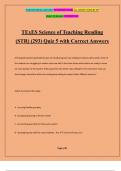
-
TExES Science of Teaching Reading (STR) (293) Quiz 5 with Correct Answers
- Exam (elaborations) • 10 pages • 2024
-
- $12.49
- + learn more
TExES Science of Teaching Reading (STR) (293) Quiz 5 with Correct Answers A first-grade teacher generally focuses on introducing one new reading or phonics skill a week. Some of the students are struggling to master each new skill in that time frame while others are ready to move on more quickly. As the teacher shifts away from the whole-class setting for this instruction, how can they change instruction within the small-group setting to support these different learners? Select all answers...
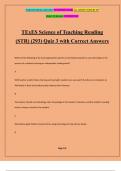
-
TExES Science of Teaching Reading (STR) (293) Quiz 3 with Correct Answers
- Exam (elaborations) • 9 pages • 2024
-
- $9.99
- + learn more
TExES Science of Teaching Reading (STR) (293) Quiz 3 with Correct Answers Which of the following is the most appropriate way for an elementary teacher to use technology in the process of a student choosing an independent reading book? A With teacher and/or library training and oversight, students can use search functions on computers to find books in their school library that relate to their interests. B The teacher should use technology, their knowledge of the student's interests, an...
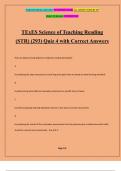
-
TExES Science of Teaching Reading (STR) (293) Quiz 4 with Correct Answers
- Exam (elaborations) • 9 pages • 2024
-
- $9.99
- + learn more
TExES Science of Teaching Reading (STR) (293) Quiz 4 with Correct Answers How are daily learning objectives related to reading developed? A by analyzing the steps necessary to reach long-term goals that are based on state learning standards B by determining what skills are naturally connected to a specific text or theme C by referencing daily learning objectives laid out in the state curriculum documents D by analyzing the results of the summative assessments from the previous year to ...
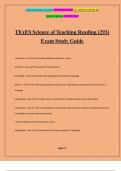
-
TExES Science of Teaching Reading (293) Exam Study Guide
- Exam (elaborations) • 7 pages • 2024
-
- $9.99
- + learn more
TExES Science of Teaching Reading (293) Exam Study Guide phonemes - Ans:-the smallest individual sounds in a word phonetics - Ans:-the sounds of human speech phonology - Ans:-the systematic organization of sounds in language phonics - Ans:-the relationship between symbols of an alphabetic writing system and sounds of a language morphology - Ans:-the study of forms of words; this includes prefixes, roots, and suffixes. morphemes - Ans:--are a combination of sounds that have meaning in spe...
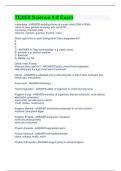
-
TEXES Science 4-8 Exam
- Exam (elaborations) • 12 pages • 2023
-
- $10.99
- + learn more
nucleotides - ANSWER-•building blocks of nucleic acids (DNA & RNA) •serve to carry packets of energy w/in cell (ATP) •monomer of nucleic acids •adenine, cytosine, guanine, thymine, uracil Which type of fire is each Extinguisher Class designated for? A B C D - ANSWER-A- Reg combustables; e.g. paper, wood B- solvents; e.g. alcohol, acetone C- Electrical D- Metals, e.g. Na Define Index Fossils. What are they used for? - ANSWER-Fossils of short-lived organisms. Help determi...
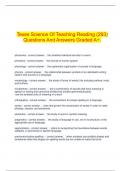
-
Texes Science Of Teaching Reading (293) Questions And Answers Graded A+.
- Exam (elaborations) • 4 pages • 2024
-
- $9.99
- + learn more
Texes Science Of Teaching Reading (293) Questions And Answers Graded A+. phonemes - correct answer. the smallest individual sounds in a word phonetics - correct answer. the sounds of human speech phonology - correct answer. the systematic organization of sounds in language phonics - correct answer. the relationship between symbols of an alphabetic writing system and sounds of a language morphology - correct answer. the study of forms of words; this includes pr...
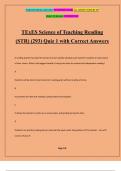
-
TExES Science of Teaching Reading (STR) (293) Quiz 1 with Correct Answers
- Exam (elaborations) • 8 pages • 2024
-
- $9.99
- + learn more
TExES Science of Teaching Reading (STR) (293) Quiz 1 with Correct Answers A reading teacher has built 50 minutes into her weekly schedule each week for students to read a book of their choice. What is the biggest benefit of using class time for student-led independent reading? A Students will be able to meet classroom reading goals without reading at home. B It promotes the idea that reading is pleasurable and enjoyable. C It allows the teacher to catch up on lesson plans and grading du...

-
TExES Science of Teaching Reading (STR) (293) Quiz 2 with Correct Answers
- Exam (elaborations) • 8 pages • 2024
-
- $12.49
- + learn more
TExES Science of Teaching Reading (STR) (293) Quiz 2 with Correct Answers A kindergarten class has been working to learn all the letters and their corresponding sounds and will later learn about types of syllables and how those syllable types can affect the sounds letters make. Students who are not progressing as planned through the lessons on letter-to-sound correspondence most likely need differentiation in the form of: A - scaffolding. B - complexity. C - background knowledge. D - pa...

How did he do that? By selling his study resources on Stuvia. Try it yourself! Discover all about earning on Stuvia


